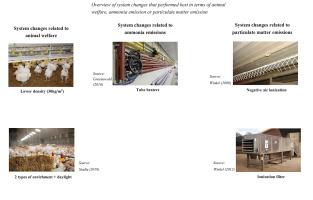Agricultural Systems ( IF 6.1 ) Pub Date : 2021-06-29 , DOI: 10.1016/j.agsy.2021.103217 Luuk S.M. Vissers , Alfons G.J.M. Oude Lansink , Helmut W. Saatkamp

|
CONTEXT
In response to societal concerns, the European Union set up goals to address the negative impact of intensive broiler production on animal welfare, the environment and human health.
OBJECTIVE
This paper aimed to 1) explore combinations of system changes that perform best in terms of farm income, animal welfare, emissions of ammonia (NH3) and particulate matter (PM10) and 2) are robust to changes in society's expectations relating to animal welfare and environmental sustainability.
METHODS
The prevailing system in the Dutch broiler market was used as a baseline for evaluating system changes. Animal welfare, NH3 emissions and PM10 emissions were the three external factors chosen for this evaluation. Farm income was quantified by the net return to labor and management (NRLM). Expert knowledge elicitation was used to identify system changes that were likely to be implemented in the baseline system. Combinations were made by selecting system changes from each of the chosen external factors. A deterministic model was used to calculate the effect of each combination of system changes on net return to labor and management. The performance of each combination was evaluated by estimating a benefit-of-the-doubt composite indicator.
RESULTS AND CONCLUSIONS
Results show that 8 out of 70 combinations indicated a better outcome and were more robust to potential changes in society's expectations relating to animal welfare and environmental sustainability. These combinations included two or more of the following system changes: ‘lower density’ (30 kg/m2), ‘2 types of enrichment’, and ‘daylight’. Furthermore, these combinations included ‘tube heaters’ for the abatement of NH3 emissions, and ‘negative air ionization system’ or ‘ionization filter’ for the abatement of PM10 emissions. To compensate for the decrease in NRLM associated with these practices and abatement techniques, a price premium was required that ranged between 4.8 and 18.5 eurocents/broiler. We conclude that combinations including animal welfare related system changes (lower density, enrichment and/or daylight), tube heaters and an ionization technique performed best and were robust to changes of societal expectations of these external factors.
SIGNIFICANCE
The insights obtained from this paper can support decision making in improving the sustainability of current broiler production systems.
中文翻译:

探索荷兰肉鸡生产系统变化的表现,以平衡动物福利、氨气排放和颗粒物排放与农场盈利能力
语境
为响应社会关注,欧盟制定了目标,以解决集约化肉鸡生产对动物福利、环境和人类健康的负面影响。
客观的
本文旨在 1) 探索在农场收入、动物福利、氨 (NH 3 ) 和颗粒物 (PM 10 )排放方面表现最佳的系统变化组合,以及 2) 对社会对动物的期望变化具有稳健性福利和环境可持续性。
方法
荷兰肉鸡市场的流行系统被用作评估系统变化的基准。动物福利、NH 3排放和PM 10排放是本次评估选择的三个外部因素。农场收入由劳动和管理净回报 (NRLM) 量化。专家知识启发用于识别可能在基线系统中实施的系统更改。通过从每个选定的外部因素中选择系统更改来进行组合。确定性模型用于计算系统变化的每种组合对劳动和管理净回报的影响。每种组合的性能通过估计疑难解答综合指标来评估。
结果和结论
结果表明,70 种组合中有 8 种表现出更好的结果,并且对与动物福利和环境可持续性相关的社会预期的潜在变化更加稳健。这些组合包括以下系统变化中的两个或多个:“低密度”(30 kg/m 2)、“两种浓缩类型”和“日光”。此外,这些组合包括用于减少 NH 3排放的“管式加热器” ,以及用于减少 PM 10 的“负空气电离系统”或“电离过滤器”排放。为了弥补与这些做法和减排技术相关的 NRLM 的下降,需要的价格溢价介于 4.8 和 18.5 欧分/肉鸡之间。我们得出的结论是,包括动物福利相关系统变化(较低密度、富集和/或日光)、管式加热器和电离技术在内的组合表现最佳,并且对这些外部因素的社会预期变化具有稳健性。
意义
从本文中获得的见解可以支持决策制定,以提高当前肉鸡生产系统的可持续性。











































 京公网安备 11010802027423号
京公网安备 11010802027423号